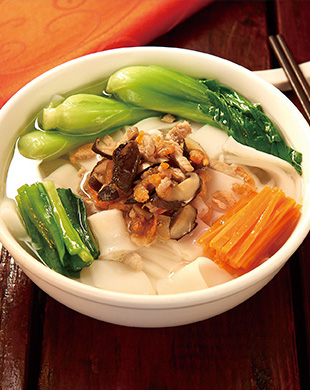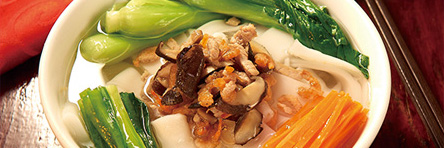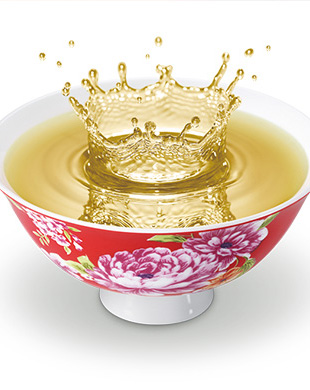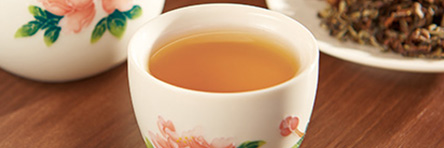Characteristics of Taiwan Hakka Food Culture

Facing environmental and seasonal changes, Hakka people in Taiwan are accustomed to utilizing local ingredients to make food. For example, fruits and vegetables are dried, pickled or turned into sauces so that their shelf life is extended. As for culinary techniques, Hakka cooks excel at simmering and stir frying a variety of dishes. Simmering is to keep ingredients below the boiling point while being heated to retain their original flavors; stir-frying is to fry ingredients in hot oil while being stirred in a wok with different seasonings and spices. Thanks to the aforementioned methods of preserving and preparing food, Taiwan Hakka cuisines exude an aroma akin to the Hakka's cherished values, that is, to love nature, treasure good fortune, and be innovative, flexible, and resourceful.
In Taiwan, rice is the staple food and tea is the most popular drink. Various ethnic groups have developed their own culture of rice and tea-based delicacies.

Facing environmental and seasonal changes, Hakka people in Taiwan are accustomed to utilizing local ingredients to make food. For example, fruits and vegetables are dried, pickled or turned into sauces so that their shelf life is extended. As for culinary techniques, Hakka cooks excel at simmering and stir frying a variety of dishes. Simmering is to keep ingredients below the boiling point while being heated to retain their original flavors; stir-frying is to fry ingredients in hot oil while being stirred in a wok with different seasonings and spices. Thanks to the aforementioned methods of preserving and preparing food, Taiwan Hakka cuisines exude an aroma akin to the Hakka's cherished values, that is, to love nature, treasure good fortune, and be innovative, flexible, and resourceful.
In Taiwan, rice is the staple food and tea is the most popular drink. Various ethnic groups have developed their own culture of rice and tea-based delicacies.

Facing environmental and seasonal changes, Hakka people in Taiwan are accustomed to utilizing local ingredients to make food. For example, fruits and vegetables are dried, pickled or turned into sauces so that their shelf life is extended. As for culinary techniques, Hakka cooks excel at simmering and stir frying a variety of dishes. Simmering is to keep ingredients below the boiling point while being heated to retain their original flavors; stir-frying is to fry ingredients in hot oil while being stirred in a wok with different seasonings and spices. Thanks to the aforementioned methods of preserving and preparing food, Taiwan Hakka cuisines exude an aroma akin to the Hakka's cherished values, that is, to love nature, treasure good fortune, and be innovative, flexible, and resourceful.
In Taiwan, rice is the staple food and tea is the most popular drink. Various ethnic groups have developed their own culture of rice and tea-based delicacies.

The Hakka is no exception. They are especially particular about food, manifested by all kinds of "Ban", or rice dishes, be it sweet, salty, white, dark green, or red. As Claude Lévi-Strauss, renowned anthropologist, once famously stated that cooking is the language through which society unconsciously reveal its structure, Hakka people in Taiwan have certainly woven rice dishes into their social and cultural fabric. A good example is Sweet Fried Ban, or Jiu Tsui È in Hakka, which signifies the Hakka's gratitude to Nüwa for saving the world. Another example is Red Ban, or Xing Ding Ban, which celebrates the birth of new family members. Finally there is Ziba, which appears in every important festival as a symbol of Hakka people's hospitality.
Tea plays an indispensable role in Hakka food culture as well. It serves as a primary cash crop for generations of the Hakka, and varieties of teas and tea-based food has become part of the Hakka people's daily life. They can choose from Lei Cha, fit for sipping and swallowing alike, or Oriental Beauty, famed for its thick and floral flavor, or Bitter Orange Tea, popular for its health benefits. In addition, they provide guests, visitors or tourists with free tea at local teahouses or teashops. Besides tea giveaways, they have even created tea-themed musicals and plays, mainly inspired by folks songs sung when Hakka people picking tea leaves, and performed during various religious, nuptial or cultural festivities.
From ingredients, cooking methods, rice and tea food to social, cultural structures on which they are based, the identity and history of the Hakka in Taiwan lie heavily in their food culture. Now, in the face of a changing society, the Hakka place equal emphasis upon tradition and innovation. Thus, a wide range of natural, healthy, and innovative Hakka food products are exported overseas. At home, rice and tea continue to feature heavily in Hakka culture and customs, through which the Hakka's wisdom and hospitality can be felt intimately.
Characteristics of Taiwan Hakka Food Culture

Facing environmental and seasonal changes, Hakka people in Taiwan are accustomed to utilizing local ingredients to make food. For example, fruits and vegetables are dried, pickled or turned into sauces so that their shelf life is extended. As for culinary techniques, Hakka cooks excel at simmering and stir frying a variety of dishes. Simmering is to keep ingredients below the boiling point while being heated to retain their original flavors; stir-frying is to fry ingredients in hot oil while being stirred in a wok with different seasonings and spices. Thanks to the aforementioned methods of preserving and preparing food, Taiwan Hakka cuisines exude an aroma akin to the Hakka's cherished values, that is, to love nature, treasure good fortune, and be innovative, flexible, and resourceful.
In Taiwan, rice is the staple food and tea is the most popular drink. Various ethnic groups have developed their own culture of rice and tea-based delicacies.

Facing environmental and seasonal changes, Hakka people in Taiwan are accustomed to utilizing local ingredients to make food. For example, fruits and vegetables are dried, pickled or turned into sauces so that their shelf life is extended. As for culinary techniques, Hakka cooks excel at simmering and stir frying a variety of dishes. Simmering is to keep ingredients below the boiling point while being heated to retain their original flavors; stir-frying is to fry ingredients in hot oil while being stirred in a wok with different seasonings and spices. Thanks to the aforementioned methods of preserving and preparing food, Taiwan Hakka cuisines exude an aroma akin to the Hakka's cherished values, that is, to love nature, treasure good fortune, and be innovative, flexible, and resourceful.
In Taiwan, rice is the staple food and tea is the most popular drink. Various ethnic groups have developed their own culture of rice and tea-based delicacies.

Facing environmental and seasonal changes, Hakka people in Taiwan are accustomed to utilizing local ingredients to make food. For example, fruits and vegetables are dried, pickled or turned into sauces so that their shelf life is extended. As for culinary techniques, Hakka cooks excel at simmering and stir frying a variety of dishes. Simmering is to keep ingredients below the boiling point while being heated to retain their original flavors; stir-frying is to fry ingredients in hot oil while being stirred in a wok with different seasonings and spices. Thanks to the aforementioned methods of preserving and preparing food, Taiwan Hakka cuisines exude an aroma akin to the Hakka's cherished values, that is, to love nature, treasure good fortune, and be innovative, flexible, and resourceful.
In Taiwan, rice is the staple food and tea is the most popular drink. Various ethnic groups have developed their own culture of rice and tea-based delicacies.

The Hakka is no exception. They are especially particular about food, manifested by all kinds of "Ban", or rice dishes, be it sweet, salty, white, dark green, or red. As Claude Lévi-Strauss, renowned anthropologist, once famously stated that cooking is the language through which society unconsciously reveal its structure, Hakka people in Taiwan have certainly woven rice dishes into their social and cultural fabric. A good example is Sweet Fried Ban, or Jiu Tsui È in Hakka, which signifies the Hakka's gratitude to Nüwa for saving the world. Another example is Red Ban, or Xing Ding Ban, which celebrates the birth of new family members. Finally there is Ziba, which appears in every important festival as a symbol of Hakka people's hospitality.
Tea plays an indispensable role in Hakka food culture as well. It serves as a primary cash crop for generations of the Hakka, and varieties of teas and tea-based food has become part of the Hakka people's daily life. They can choose from Lei Cha, fit for sipping and swallowing alike, or Oriental Beauty, famed for its thick and floral flavor, or Bitter Orange Tea, popular for its health benefits. In addition, they provide guests, visitors or tourists with free tea at local teahouses or teashops. Besides tea giveaways, they have even created tea-themed musicals and plays, mainly inspired by folks songs sung when Hakka people picking tea leaves, and performed during various religious, nuptial or cultural festivities.
From ingredients, cooking methods, rice and tea food to social, cultural structures on which they are based, the identity and history of the Hakka in Taiwan lie heavily in their food culture. Now, in the face of a changing society, the Hakka place equal emphasis upon tradition and innovation. Thus, a wide range of natural, healthy, and innovative Hakka food products are exported overseas. At home, rice and tea continue to feature heavily in Hakka culture and customs, through which the Hakka's wisdom and hospitality can be felt intimately.




